| On a clear day it is possible to see the path of an
aircraft high in the sky, travelling to some far off destination. The path
is clearly marked by a vapour trail that has a defined width, and remains
in the sky for a long period after the aircraft has passed. The vapour
trail is technically known as an aircraft wake vortices. At many hundreds of miles per hour, the
strength of the vortices generated by the wings and fuselage cutting
through the air, and added too by the thrust from the jet engines, are
enormous. |
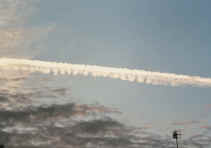 |
| The disturbance generates spiralling cones of air (the
vortices), much like a tornado. The force of the vortices takes a long
time to dissipate as there is little in the upper atmosphere to slow it
down. |
|
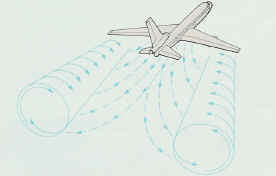 |
| Closer to the ground large aircraft travel much slower, and
the atmosphere is much thicker, so the vortices that are generated are
less powerful and dissipates quicker. The most critical period is when a
large aircraft is coming into land, when it is common for the aircraft
wake vortex to reach the ground. The force of the vortex can suck tiles or
slates off the roofs close to the flight path. |
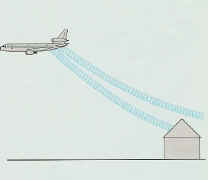 |
|
The main risk factors |
| The risks of being affected by an aircraft wake
vortices can be assessed by looking at various know factors |
- Is the location of the building under the flight path into a major
airport or military air base? The flight path can be up to 10 degrees
either side of the centre line and up to 6Km from the touchdown point.
|
|
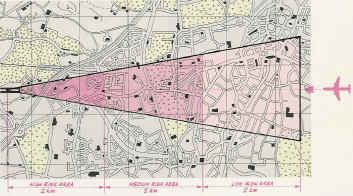 |
- The direction of landing. More damage is created by aircraft coming
in to land than taking off, due to the shallow rate of decent,
relative to the steep rate of climb when taking off. Coming in to land
the aircraft are lower beyond the end of the runway
|
- The size and weight of the aircraft, and the speed at which they
land can make a big difference. It is the wide-bodied aircraft that
record the most strikes, as there are more surfaces on the aircraft to
generate the vortices.
|
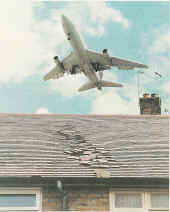 |
|
|
|
Vortex strikes |
| Unlike hurricane force winds, which affect the
perimeters of a roof (especially the ridge and verge), aircraft wake
vortices damage occurs in the centre of a roof slope, as the edges of the
roof break up the vortices rather than help it. The average vortex is
approx. 500mm wide, will travel at about 5 Knots, and last for approx. 3
minutes in clear air. Once it comes into contact with a roof, the vortices
can exert their total force of up to -1200N/mē on just one or two slates
or tiles for a fraction of a second, before they break up and loses their
energy. If the tiles or slates are not fixed securely, the sucking and
twisting action of the vortices can lift them out of place. |
|
 |
|
Fixing specification |
| To resist the force of the vortices it is
essential that the tiles and slates can not lift at the tail of the tile
or slate, and can not rotate. This can be achieved with tiles by being
head nailed to the batten and tail clipped with a rigid clip. The smaller
the tiles the more fixing can be installed per square metre of roof. Plain
tiles should be fixed with either ring shank nails with a thick strong
nail head or screwed. For double lap slate, centre nailing with ring shank
nails should be adequate.
Roofs clad with metal sheeting or built up systems do not appear to be
vulnerable to aircraft wake vortices damage as the small footprint of a
vortex relative to the large surface area of the panel will allow the load
to spread to a greater number of fixings. |
|
Program of repairs |
| The existing roofs that are under the flight
path into major UK airports, starting with London Heathrow, are likely to
be subject to a planned or programmed roof replacement scheme. However for
all new buildings under a flight path it is the responsibility of the
designer/ specifier to ensure the correct fixing specification is used to
ensure no roof damage is caused by the effect aircraft wake vortices. In
most instances the airport authority will be able to advise if the size of
aircraft using the airport is an issue, and the exact line of the flight
paths. With this information, the assistance of the roof tile or slate
manufacturer should next be sought to determine the correct fixing
specification for the roof. |
|
Further reference |
| To assist designers and engineers, the Building
Research Establishment has produced a Digest number 467 entitled
"Slate & Tiled Roofs: Avoiding Damage from Aircraft Wake
Vortices", giving all the information needed, including sample
calculations. |
|
Conclusion |
| The number of pitched roofs in the UK that may
be affected by aircraft wake vortices is very small, but the affect an
aircraft wake vortex can have on a pitched roof can be very disruptive.
The development of some brown field sites under the flight path into
airports, and the extension of existing airports to take more air traffic
will increase the overall number of roofs that could be affected. It is
therefore important for building designers and specifiers, who intend to
build near an airport to understand and be aware of the potential problems
that aircraft wake vortices can have and where to get the information
needed to ensure it does not become a problem for their project. |